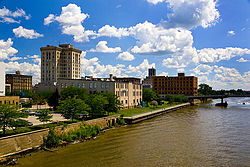History of Saginaw, Michigan
The history of Saginaw, Michigan explores the development of the city from the time that Native American hunter-gatherers ranged through the area.
More recently, economic development in the region is focused on comparative advantages in innovation, clean energy, and continued manufacturing exports.
This may be due, in part, to the low lying and frequently flooding land adjacent to the Saginaw River, much of which was marshland prior to being drained in the 19th century.
Henri Nouvel, a Jesuit missionary who made repeated visits to the Native Americans present in the area, is of particular significance.
The French controlled the territory consisting of the present day State of Michigan until it was ceded to the British following the Seven Years' War in 1763.
The French established permanent settlements in many locations throughout the Great Lakes, but most of the interior of the Lower Peninsula of Michigan, including the Saginaw River valley, was undeveloped.
Both the French and the British primarily maintained settlements for trade and strategic defense, neither of which provided much reason to develop the Saginaw region.
The first permanent white settlement in the area was a fur-trading post on the west side of the Saginaw River established in 1816 by Louis Campau.
[4] The U.S. federal government extinguished Native American interests for most of the land in the area with the Treaty of Saginaw in 1819, clearing the way for white settlers.
The town languished for most of the following decade, but was re-platted in December 1830, comprising river front from Cass St. on the south to Harrison St. and north to Jefferson.
[8] On July 12, 1830, the Territorial Legislature passed an act that erected the Township of Saginaw, effective with the first town meeting on April 4, 1831.
The convenient access to water transportation provided by the Saginaw River and its numerous tributaries fueled a massive expansion in population and economic activity.
As the trees were being felled in the region, logs were floated down the rivers to sawmills located in Saginaw, then to be loaded onto ships and later railroad cars.
In addition to salt production, which experienced an eventual decline as well, growing industries supporting the area's agriculture and manufacturing developed.
Specifically, Saginaw was home to one production facility that produced over half a million M1 Carbine rifles for the US Military during World War II.
In the years following World War II, the legislature of the State of Michigan enacted laws making it increasingly difficult for incorporated cities to expand by annexing adjacent territory contained within townships.
Residential growth in neighboring townships led the City of Saginaw to provide water under long-term contracts to such other units of government.
As a result of migrations of workers from other parts of the United States, particularly the south, Saginaw's African-American population expanded significantly in proportion to those of European ancestry.
Attitudes of racism promoted the segregation of African-American residents into concentrated neighborhoods almost exclusively within the city's east side.
Mortgage lenders and real estate sales agents enacted redlining tactics to control where African-Americans lived.
After the eventual breakdown of institutionally enforced segregation and increased opportunities for African-Americans, however, the west side has become significantly more diverse in its ethnic and racial composition and no longer has almost exclusively white residents.
Saginaw has experienced a significant rate of crime activity while at the same time being forced to decrease the size of its police department.
Currently, economic development is focused on comparative advantages in innovation, clean energy, and continued manufacturing exports.
Compared to other mid-sized communities, Saginaw has a disproportionately high number of patents per employee, and more than 81 times the average US share of jobs in photovoltaic technology research and production.










